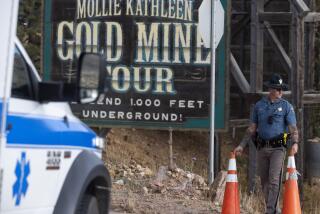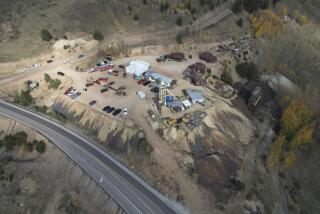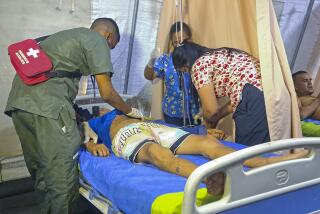Cave-in process OK’d at mine
- Share via
WASHINGTON — The mining technique used in Crandall Canyon Mine in Utah, where six miners are trapped, involved collapsing the roof of the mine -- a method that dislodges such tremendous volume of earth with such force that it causes quake activity.
“It’s the most dangerous type of mining that there is,” said Tony Oppegard, a mining lawyer and former federal mine safety official.
In June, U.S. regulators approved a roof control plan for the “room and pillar” technique, also known as retreat mining, at Crandall Canyon.
It’s a delicate endeavor: Columns of coal are left in place to hold up the roof of the mine while the vein is tapped. Once the reserves have been extracted, the miners harvest the last of the coal on the way out, cutting carefully into the pillars and scrambling out of the way as the roof caves in.
The final column to be slashed is known among miners as the “suicide pillar.”
The Mine Safety and Health Administration, part of the Department of Labor, signed off on Crandall Canyon’s pillar safety plan, spokeswoman Amy Louviere said. The mining agency will investigate whether the mine was complying with the agreed-upon procedures.
Robert E. Murray, president of Murray Energy Corp., which operates the mine, said Tuesday that there was no retreat mining in the immediate vicinity of the miners and that the collapse was caused by an earthquake.
But Don Blakeman, an analyst at the National Earthquake Information Center in Golden, Colo., said Tuesday that Monday’s tremor near the mine -- registering 3.9 on the Richter scale -- “just doesn’t look like a natural event.”
Seismographers at the University of Utah also said that wave patterns from the shock were consistent with the type “induced by underground coal mining” but that a quake along nearby fault lines could not be ruled out because those also occur in central Utah. In 1988, a magnitude-5.2 earthquake was recorded within 40 miles of the mine.
In the Utah coal belt, university scientists said, mine tremors account for about 25% of seismic activity; the other 75% are produced by the activity of tectonic plates.
If Murray is right, and a natural earthquake caused the collapse, that would be a first in Utah.
“We haven’t seen an earthquake followed by a mine collapse,” said Relu Burlacu, manager of the university’s seismograph stations. But the opposite has certainly been the case.
Initial studies suggest that particular mining areas are creating most of the tremors.
“We’ve seen events in the vicinity of this mine in the past,” Burlacu said. Most of the seismic activity, he added, is caused by mining at deeper levels. The Crandall Canyon miners are 1,500 feet underground.
The mining-induced quakes, recorded over many decades, have had magnitudes in the 3.5 to 4.2 range, about the strength of Monday’s shaking.
To reach a solid conclusion, Burlacu said, scientists will need more precise information from the company about the time of Monday’s collapse. The tremor was recorded at 2:48 a.m.
Quakes have been linked to both “longwall” and “room-and-pillar” mining. Each method involves allowing the roof of the mine to fall.
In longwall mining -- more common in Utah, according to the state mining association -- the miners move artificial roof supports as they work, allowing the top of the mine where they are finished to cave in behind them.
All coal mining is risky, but the last phase of room-and-pillar mining is disproportionately dangerous, the National Institute for Occupational Safety and Health has found. In a 2003 study, the institute reported that retreat mining accounted for 10% of U.S. coal production, but 27% of mining deaths.
But Luke Popovich, a spokesman for the National Mining Assn., said the institute’s sample was small -- 100 fatalities.
“I’m not sure what we can say statistically about the relative risk of this technique,” he said.
In April, a group of mining widows met in Harlan, Ky., with Assistant Labor Secretary Richard E. Stickler, who heads the Mine Safety and Health Administration. According to Oppegard, the mine safety attorney, the women asked Stickler to push Congress for more protective measures for miners. Retreat mining was one of their concerns.
--
Times staff writer David Zucchino contributed to this report.
More to Read
Sign up for Essential California
The most important California stories and recommendations in your inbox every morning.
You may occasionally receive promotional content from the Los Angeles Times.










